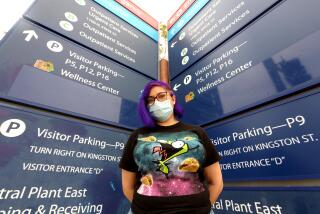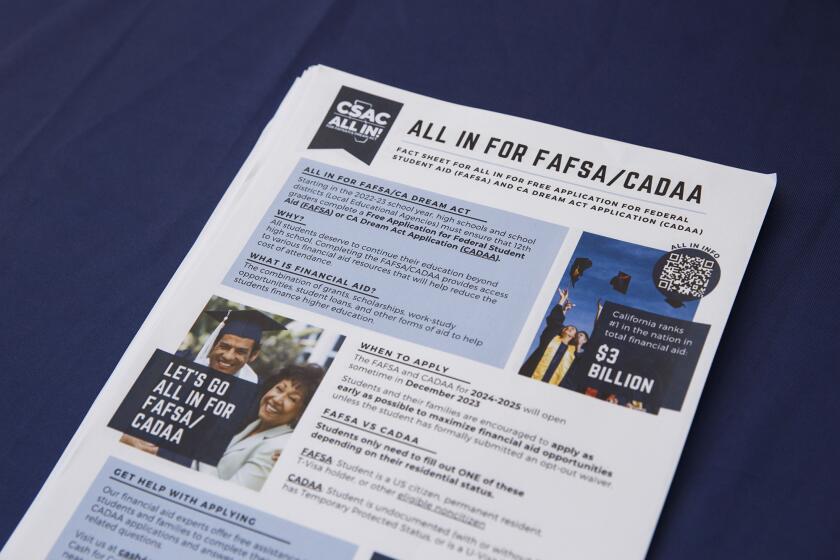Documents Cite Earlier Denials of Health Care : Budget: County clinics to begin refusing new, unscheduled patients earlier than announced Oct. 1 date, according to department memos.
As the Los Angeles County Board of Supervisors began the process of slashing health services even further Tuesday, clinic employees were being told to begin turning away the sick and injured at least a month before the publicly announced closure date, health department documents show.
In adopting their $12-billion budget last week, the supervisors said they were postponing dramatic cuts in health services until Oct. 1 to give officials breathing room to continue their desperate search for more help from the state and federal governments.
But a “facility closure/contingency plan” submitted to the supervisors Tuesday established Sept. 1 as the date clinics and health centers would start rejecting new and unscheduled patients as a prelude to shutting down completely Oct. 1. Other information being circulated by the county put the date for the new restrictions even earlier.
One health department memo lists next Tuesday--Aug. 15--as the date clinics should reject new patients, those with unscheduled appointments and those transferring from other facilities. Another memo, a “budget crisis bulletin” dated Aug. 7, tells clinics within the San Fernando cluster of health centers to alert all employees not to accept any requests for appointments that come in on or after Aug. 15.
Also beginning Aug. 15, the bulletin said, “We are not to accept any patients for walk-in or immunization services.”
Although the supervisors have so far spared the county’s six hospitals, officials are planning to eliminate 75% of outpatient services now being offered at those facilities. The county has slated for closure 28 of 39 clinics and all of its six comprehensive health centers. The clinics that will remain open will provide only the most basic of public health services, primarily designed to prevent the spread of communicable diseases.
Supervisor Zev Yaroslavsky met with the health department Tuesday afternoon in an attempt to keep open the Mid-Valley Comprehensive Health Center in Van Nuys, suggesting that the less-busy Pacoima Health Center be closed instead.
“I’ve asked the health department to review their decision to see if there is a more centrally located place,” said Yaroslavsky, who represents the area. “Of all the clinics in the San Fernando Valley, [the Van Nuys clinic] serves the most people . . . It just makes sense to keep open the clinic that already serves the largest clientele.”
Although the Van Nuys clinic was damaged by the Northridge earthquake, it has handled about 60,000 patient visits so far this year, compared to about 20,000 at the smaller Pacoima clinic, Yaroslavsky said.
Additionally, the supervisor said, people from the West Valley in need of health services are closer to Van Nuys than they are to the northeast Valley.
On Monday, the health department announced that six of the Valley’s eight health clinics would be closed, including those in Canoga Park, Tujunga, Burbank, North Hollywood, San Fernando and the Mid-Valley center in Van Nuys. Those in Glendale and Pacoima would remain open, the announcement said.
A clinic in Valencia is also scheduled to close and one in Lancaster would remain open.
Advocates were alarmed at the health documents revealed Tuesday, which indicate a brisker pace for the phasing out of many health services. They contended that the public has been lulled into a false sense of security, relying on the Oct. 1 date repeatedly cited by county officials.
*
Susan Fogel of the California Women’s Law Center said lives could be endangered because many people showing up at health clinics expecting immediate treatment will not get it, particularly new patients and those without appointments. As a result, her legal center and other advocacy groups have threatened the county with lawsuits if they try to shut the clinics down so soon.
“There is a misperception that somehow Oct. 1 is some magic date when the county will begin turning people away,” Fogel said. But as early as next Tuesday, many of those people needing treatment, she said, “will show up and be sent somewhere, God knows where.”
Fogel and other health advocates contend that the county Department of Health Services has exacerbated the situation by giving confusing and often contradictory answers to those who try to find out when clinics will begin restricting access, and to whom.
“What we have stressed with the board [of supervisors] over the past month is that they have to do adequate planning and they have to tell people. I absolutely don’t think people know this,” said Beth A. Osthimer, senior attorney at the San Fernando Valley Neighborhood Legal Services. “We are trying to do outreach and when people hear this they are flabbergasted.”
Health Services Department spokeswoman Toby Staheli said Aug. 15 had been an unofficial “discussion” date for turning people away from clinics, but said that as of Tuesday, the official date will be Sept. 1. As for clinics still telling employees to restrict access next week, she said: “Maybe they took those [earlier] discussions as policy. I’ll have to find out.”
Whether the clinics and comprehensive health centers begin turning people away next week or in September, the legal advocacy groups contend that the county’s safety net will drop far below what is mandated by state and federal standards. The clinics provide services including life-saving drugs and medications, chemotherapy, high-risk pregnancy monitoring, treatment of broken bones and other traumatic injuries, biopsies and post-operative burn treatments.
In a detailed letter to the supervisors and Health Services Director Robert C. Gates, the coalition of legal aid groups contend that the cuts would be a “virtual meltdown of the indigent care safety net in Los Angeles,” and that they intend to sue if and when they are implemented.
“If these cuts are put into place, there certainly will be every type of action taken to stop them,” said Fogel. “It is a terrible tragedy. The public is unaware of the magnitude of the consequences to the public health of all of Los Angeles County. It is also illegal; the county has a legal obligation to provide indigent health care.”
Health officials have had no comment on potential lawsuits. But in one of their memos to employees, they refer anyone requesting information on the closures to lawyers in the county counsel’s office.
As concerns mounted about the timing of the health cutbacks, supervisors at their weekly board meeting Tuesday gave Chief Administrative Officer Sally Reed seven days to prepare a detailed blueprint for slashing another $25 million to $75 million in health care services, on top of the more than $500 million in health cuts approved last week.
The supervisors said they needed to identify potential cuts now because of Gov. Pete Wilson’s veto last week of a bill that would have allowed them to siphon $75 million in transit funds in each of the next five years for health services. Wilson has suggested he would support a one-time infusion of $50 million for the county, but even that cannot be counted on until the state Legislature reconvenes Aug. 21.
The supervisors also approved the hiring of an independent cash flow adviser to make sure they do not run out of cash during the year, an unusual safety measure proposed by Reed because of the county’s precarious financial situation.
At least $300 million of the money in the supervisors’ annual spending plan is not guaranteed, and Reed said she wanted to make sure the additional strains on the county’s cash flow do not result in it running out of cash.
Before the day was out, county officials had interviewed representatives from at least one of the firms in contention for that job. Saybrook Capital Corp., a Los Angeles-based investment banking firm, is financial adviser to creditors in the Orange County bankruptcy case that were participants in the county’s failed investment pool.
“We talked to them this morning,” said Sandra Davis, assistant chief administrative officer. “We will be talking to others, and plan to act very quickly.”
During the board’s discussion on whether to hire a cash flow adviser, board Chairwoman Gloria Molina suggested that the supervisors instead appoint a blue-ribbon task force similar to one created to restructure the county’s health care.
The panel, she said, would take a broader view of the county’s financial affairs. Instead of simply monitoring its incoming revenues and outgoing expenses, it would analyze the entire budgeting process, develop strategies on downsizing the entire county government and work to improve ways of securing state and federal revenue--which outnumber county-originated dollars in its budget 5 to 1.
At least one supervisor scoffed at Molina’s idea. “They’d probably recommend another czar,” as the health crisis task force did, said Supervisor Yvonne Brathwaite Burke. “We don’t need another czar. We’re going to have nothing but czars and czarinas around here.”
The board put off discussion on that matter until next week.
County officials confirmed Tuesday that newly appointed health czar Burt Margolin and four associates helping the county restructure its health system are in line to receive $175,000 for six months work.
*
The contract, which must be approved by the supervisors, was negotiated by Margolin’s public policy firm and county officials. In addition to support staff provided by the county, the former state assemblyman will have at least one associate in Los Angeles, one in Sacramento and two in Washington, county officials said.
Also Tuesday, Reed told the supervisors that the county is continuing to have problems in getting reimbursement from the federal government for earthquake repairs, including County-USC Medical Center.
The Times reported Saturday that the county government headquarters building, the Hall of Administration, was damaged nearly beyond repair, and that refurbishing it would be enormously expensive.
While the county has not yet sought federal funds to help it perform earthquake-related repairs at its headquarters, it has done so for hospitals and other buildings. Reed said the Federal Emergency Management Agency is insisting on pursuing a “patch and paint” approach that does not address structural issues.
“They consistently manage to divide by 50 or 100 to give us the number they think is appropriate,’ Reed said.
More to Read
Sign up for Essential California
The most important California stories and recommendations in your inbox every morning.
You may occasionally receive promotional content from the Los Angeles Times.










